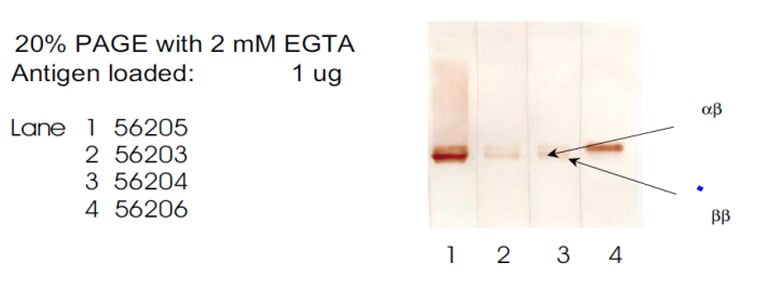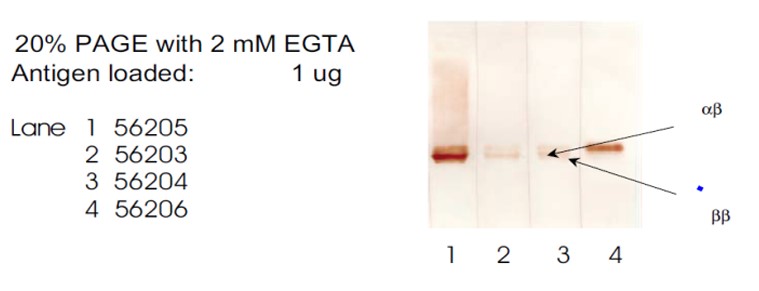| Weight | 1 lbs |
|---|---|
| Dimensions | 9 × 5 × 2 in |
| host | mouse |
| isotype | IgG1 |
| clonality | monoclonal |
| concentration | 1 mg/mL |
| applications | ICC/IF, WB |
| reactivity | S100α/β |
| available sizes | 100 µg |
mouse anti-S-100 monoclonal antibody (8B10) 8253
$338.00
Antibody summary
- Mouse monoclonal to S-100
- Suitable for: WB,ELISA,AP
- Isotype: IgG1
- 100 µg
mouse anti-S-100 monoclonal antibody (8B10) 8253
| antibody |
|---|
| Tested applications WB,ELISA |
| Recommended dilutions These antibodies may be used in ELISA and Western blot (human brain): 56203, 56204, and 56206 may be used to affinity-purify S-100.Recommended pairs for sandwich ELISA: Capture Detect 56203 56204 56206 56204 |
| Immunogen Purified S-100 protein from human brain. |
| Size and concentration 100µg and lot specific |
| Form liquid |
| Storage Instructions These antibodies are stable for at least one (1) year at -20°C to -70°C. Avoid multiple freeze-thaw cycles. |
| Storage buffer PBS, pH 7.4, 0.09% NaN3 |
| Purity protein affinity purification |
| Clonality monoclonal |
| Isotype IgG1 |
| Compatible secondaries goat anti-mouse IgG, H&L chain specific, peroxidase conjugated polyclonal antibody 5486 goat anti-mouse IgG, H&L chain specific, biotin conjugated, Conjugate polyclonal antibody 2685 goat anti-mouse IgG, H&L chain specific, FITC conjugated polyclonal antibody 7854 goat anti-mouse IgG, H&L chain specific, peroxidase conjugated polyclonal antibody, crossabsorbed 1706 goat anti-mouse IgG, H&L chain specific, biotin conjugated polyclonal antibody, crossabsorbed 1716 goat anti-mouse IgG, H&L chain specific, FITC conjugated polyclonal antibody, crossabsorbed 1721 |
| Isotype control Mouse monocolonal IgG1 - Isotype Control |
| target relevance |
|---|
| Protein names Protein S100-A1 (S-100 protein alpha chain) (S-100 protein subunit alpha) (S100 calcium-binding protein A1) |
| Gene names S100A1,S100A1 S100A |
| Protein family S-100 family |
| Mass 10546Da |
| Function FUNCTION: Small calcium binding protein that plays important roles in several biological processes such as Ca(2+) homeostasis, chondrocyte biology and cardiomyocyte regulation (PubMed:12804600). In response to an increase in intracellular Ca(2+) levels, binds calcium which triggers conformational changes (PubMed:23351007). These changes allow interactions with specific target proteins and modulate their activity (PubMed:22399290). Regulates a network in cardiomyocytes controlling sarcoplasmic reticulum Ca(2+) cycling and mitochondrial function through interaction with the ryanodine receptors RYR1 and RYR2, sarcoplasmic reticulum Ca(2+)-ATPase/ATP2A2 and mitochondrial F1-ATPase (PubMed:12804600). Facilitates diastolic Ca(2+) dissociation and myofilament mechanics in order to improve relaxation during diastole (PubMed:11717446). {ECO:0000269|PubMed:11717446, ECO:0000269|PubMed:12804600, ECO:0000269|PubMed:22399290, ECO:0000269|PubMed:23351007}. |
| Subellular location SUBCELLULAR LOCATION: Cytoplasm {ECO:0000269|PubMed:15171681}. Sarcoplasmic reticulum {ECO:0000269|PubMed:12804600}. Mitochondrion {ECO:0000250|UniProtKB:P56565}. |
| Tissues TISSUE SPECIFICITY: Highly prevalent in heart (PubMed:12804600, PubMed:1384693). Also found in lesser quantities in skeletal muscle and brain (PubMed:1384693). {ECO:0000269|PubMed:12804600, ECO:0000269|PubMed:1384693}. |
| Structure SUBUNIT: Dimer of either two alpha chains, or two beta chains, or one alpha and one beta chain (PubMed:21296671). Also forms heterodimers with S100P (PubMed:15171681). Interacts with AGER (By similarity). Interacts with CAPZA1 (By similarity). Interacts with FKBP4 (PubMed:20188096). Interacts with RYR1 and RYR2 (PubMed:18650434). Interacts with CACYBP in a calcium-dependent manner (PubMed:12042313). Interacts with PPP5C (via TPR repeats); the interaction is calcium-dependent and modulates PPP5C activity (PubMed:22399290). Interacts with ATP2A2 and PLN in a Ca(2+)-dependent manner (PubMed:12804600). Interacts with mitochondrial F1-ATPase subunits ATP5F1A and ATP5F1B; these interactions increase F1-ATPase activity (By similarity). {ECO:0000250|UniProtKB:P35467, ECO:0000250|UniProtKB:P56565, ECO:0000269|PubMed:12042313, ECO:0000269|PubMed:15171681, ECO:0000269|PubMed:18650434, ECO:0000269|PubMed:20188096, ECO:0000269|PubMed:21296671, ECO:0000269|PubMed:22399290}. |
| Post-translational modification PTM: Glutathionylated; glutathionylation increases affinity to calcium about 10-fold. {ECO:0000269|PubMed:15885104}. |
| Target Relevance information above includes information from UniProt accession: P23297 |
| The UniProt Consortium |
Publications
Warning: Cannot modify header information - headers already sent by (output started at /www/benchmarkantibodiescom_769/public/wp-includes/script-loader.php:3015) in /www/benchmarkantibodiescom_769/public/wp-content/plugins/shortcode-manager/shortcode-manager.php(453) : eval()'d code on line 3
Publications
| pmid | title | authors | citation |
|---|---|---|---|
| We haven't added any publications to our database yet. | |||
Protocols
| relevant to this product |
|---|
| Western blot IHC ICC |
Documents
| # | SDS | Certificate | |
|---|---|---|---|
| Please enter your product and batch number here to retrieve product datasheet, SDS, and QC information. | |||
Only logged in customers who have purchased this product may leave a review.









Reviews
There are no reviews yet.